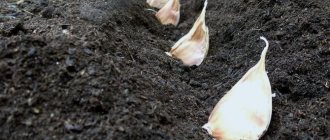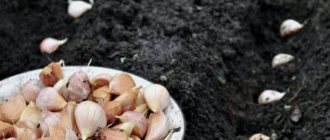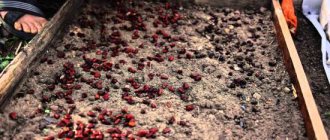The main differences between winter and spring garlic
Winter garlic bolts, that is, during growth it produces a so-called arrow. It is very frost resistant. It is planted in late autumn. After winter, by the next season, we get large, full-fledged heads. This is a high-yielding type of garlic. It also differs in that its heads are stronger, of higher quality, and have fewer cloves.
Propagating garlic requires certain skills and knowledge.
Spring garlic does not shoot. Its planting is carried out in the spring. Its main advantage is that it is stored for a long time. However, it does not produce such a rich harvest. Common features and differences between spring and winter garlic:
| Spring garlic | Winter garlic |
| Small onions. Unharvest. Spring varieties do not shoot. | Large onions. High-yielding. Winter varieties shoot and have airy bulbs. With their help, garlic reproduces. |
| Spring garlic is planted in open ground in early spring. It tolerates spring frosts well. | Winter garlic is planted in open ground in the fall. Frost-resistant species. |
| The bulb contains up to 30 cloves. | The head contains less than ten teeth. |
| The teeth are arranged in a spiral (the closer they are to the center, the smaller they are). | The teeth are arranged around the main shaft in one row. |
| Excellent preservation. | Doesn't last long. |
| Propagated by planting cloves. | Reproduces by bulblets and cloves. |
| The growing season is short | The growing season is long. |
Growing garlic in open ground
Garlic planted in a summer cottage has a positive effect on the growth of other garden crops, and when ripe it can be useful as a health booster.
The timing of planting garlic depends on its variety. The spring and winter species have different planting times; there are also other differences between them. Our article provides information about these two types of garlic and the secrets that gardeners need to know, as well as a detailed description of how this crop helps gardeners in their garden beds.
The conditions for growing garlic are quite simple, but some features must be taken into account. This vegetable needs the soil in which it will be planted to be fertile; a good harvest can be obtained on cultivated sandy and loamy lands with neutral acidity.
Garlic should be planted in a sunny area because the plant needs sunlight. Most often, this crop is grown in the garden, but sometimes, to save space, together with other vegetables or berries. Garlic is best planted next to:
- Strawberries;
- Bow;
- Cucumbers;
- Malina;
- Strawberries;
- Potatoes;
- Gooseberries;
- Blackcurrant.
A good neighbor would be a vegetable for these flowers: gladioli, tulips and roses.
Garlic repels pests from its neighbors - other plants. Even a mole will not dig a hole next to this vegetable. Roses also need close proximity to this crop, as this saves the flowers from spotting.
Garlic planted nearby inhibits and slows down the growth of cabbage, beans, and peas. At the same time, these cultivated plants are good predecessors for the subsequent cultivation of garlic, just like pumpkin.
On an onion bed or your own bed from last year, agricultural technology for growing vegetables is possible only after 4 years.
Garlic propagation methods
Garlic reproduces vegetatively. Winter species - also through seeds. From spring garlic, only the cloves of the heads are selected for planting. Winter crops are bred both with cloves and seeds from aerial bulbs (the so-called bulbs). In the latter case, it takes two years to obtain a harvest of large, beautiful and healthy heads.
In the first year, the aerial bulb produces a small seed head, which consists of a single clove. It has the same properties as full-fledged garlic. However, only next year an ordinary head with many teeth will grow from the set. Ordinary gardeners often prefer winter garlic because it produces a high yield.
How does garlic reproduce?
The head of garlic is not integral in its structure, but is divided into cloves (slices). The lobules are attached to one common maternal bottom. Such a clove is considered a separate organism. The number of lobules in one head can be quite different.
The minimum number of cloves is 4, and the maximum does not exceed three dozen. The size of the cloves depends on their number: the fewer cloves, the larger they are. One head combines large and small teeth. Large cloves are located closer to the edge, and small ones inside them. They are used as planting material. This is how garlic reproduces.
In agriculture, there are two types of garlic: bolting and non-bolting. Both of these species have two varieties: winter and spring. Both varieties are not very different from each other. When planting garlic in the spring, gardeners receive a harvest in the form of single-clove heads.
Winter garlic is resistant to frost and ripens 20 days earlier than spring garlic. Winter garlic is also more fertile and has a sharper taste. The only disadvantage of winter garlic compared to spring garlic is the short storage period.
Propagation of garlic by aerial bulbs
To obtain mature bulb bulbs, you should wait until the garlic inflorescences are fully formed and the film covering them cracks. Then the inflorescences are cut off along with the arrows at a height of 20-30 centimeters and dried properly. If the bulbs are planned to be planted in the spring, they should be stored in dried form in inflorescences. If it is in the fall, the aerial bulbs need to be dried for 30-40 days and only then planted.
Garlic planted from bulbs will ripen in a longer period than usual, but it will be of better quality, and its grade will be preserved. A full-fledged head with many teeth will be obtained only after 2-3 years. In the first year, an onion from one clove weighing 0.5-5 grams ripens - this is a set, from which in the second year a single-clove onion will also grow, but a little larger in size. They also plant it and next year they finally get a full-fledged head.
Thus, garlic must go through 4 stages:
- air bulb bulb,
- single-toothed onion set,
- a large onion set consisting of one clove,
- full head.
To propagate garlic using arrows, they are also called bulbs, you need to wait until the plant has fully sprung and an arrow appears at the top, which will develop into a bulb.
Diseases and pests
| Root rot Ways to fight:
| |
| Cervical rot Ways to fight:
| |
| Onion moth Ways to fight:
|
Advantages of propagation by aerial bulbs
- When using this method, it is possible to more quickly obtain valuable crop varieties.
- The aerial bulbs produce very healthy and high-quality heads.
- This method makes it possible to avoid the stem nematode, an active insect pest of the crop that attacks the bottom without penetrating the inflorescence, which allows the bulbs to remain safe and sound, and undamaged heads grow from them.
Garlic from bulbs can be grown using two methods:
- with transplantation: the seedling is planted in the same year it was dug up - in the fall or next spring;
- The seedlings remain in the soil for the winter. And next year it produces a large head.
Harvesting
Harvesting garlic from the garden, like harvesting onions, should be done in a timely manner. Winter varieties do not store well, so do not delay digging up and drying the bulbs. It is necessary to take into account weather conditions; if prolonged rains are expected, then the garlic must be dug up in advance. Long and hot summers help to increase the rate of garlic ripening.
Harvesting is best done earlier, as is the case with onions. Garlic that has been in the ground for too long cannot be stored for long, as it crumbles and falls apart. Immature bulbs also quickly wither and deteriorate. Therefore, it is best to selectively harvest mature bulbs.
You can determine that the garlic is ripe and needs to be dug up by the leaves that have turned yellow and withered by a quarter of their length. However, when using this method, there is a high probability of errors occurring, since the plant may suffer from diseases or excessive acidity or soil moisture.
The main landmark is the end of the period of maturation and growth of the plant, which occurs 100 - 110 days after the appearance of the first shoots. Each variety will have its own end date for the growing season.
You can also navigate by the bulbs; as soon as the shell in which they are enclosed bursts, you need to harvest. But this method also does not always indicate the correct harvest date. Sometimes already ripe heads remain covered with a shell for quite a long time.
Propagation of garlic from cloves
To cultivate garlic without any problems, you need to choose the right place for planting. Due to the fact that spring garlic is planted in the spring, and winter garlic in the fall, climatic conditions must be taken into account when choosing a place and type. For example, in regions with cold climates, winter varieties are predominantly grown, and in warm climates, spring varieties are grown.
Tip #1. Winter garlic is resistant to low temperatures, but it is necessary to time the planting so that the cloves take root but do not produce leaves.
Plant it about 3 weeks before the soil starts to freeze. Spring garlic is planted in the spring, when the soil is already prepared for it. Garlic bulbs need to be divided into cloves. For planting, the best quality, large cloves are used. Garlic should be planted in rows every 25 centimeters. In one row, the distance between the cloves is 8-10 centimeters.
Winter garlic cloves should be planted in the soil to a depth of 7 centimeters, spring garlic – 5 centimeters. The distance in one row between the bulbs is 2 centimeters. The gap between rows is approximately 10 centimeters. Winter garlic should be covered with a layer of humus or peat, and on top with branches. Garlic cannot be planted in one place for more than two years in a row, otherwise it will not grow healthy and strong. It is advisable to grow it every year in different beds.
Where garlic is sown, potatoes or onions should not grow previously. You can sow garlic after pumpkin, cucumbers, cabbage, beets, and legumes. Garlic beds should be well lit. They can be located near berry bushes (strawberries, black currants, gooseberries, raspberries), vegetables (cucumbers, carrots, potatoes), flowers (roses, tulips, gladioli). In this case, the garlic will not become infected with black spot.
Many gardeners and gardeners prefer the method of propagation using cloves, as it is suitable for both types of garlic and works great, producing a large harvest.
Useful properties of garlic
The beneficial substances contained in garlic help reduce blood pressure, relieving tension in the functioning of blood vessels.
Garlic contains vitamins A, K, E, C and vitamins B and B12 , as well as thymine, riboflavin, folate, niacin . In addition, the vegetable contains selenium, iron, copper, manganese, zinc, and phosphorus.
Scientists confirm that garlic helps cope with the following diseases:
- lack of vitamins;
- spread of parasitic worms;
- infections of a bacterial or viral nature;
- heart and vascular diseases;
- hypertension;
- impotence;
- thrombophlebitis and venous diseases;
- joint diseases;
How to care for garlic
In order to get a good, high-quality harvest, you must follow agricultural techniques when caring for garlic, which means:
- water,
- mulch,
- loosen,
- weed,
- feed.
Plants need to be watered once a week. For 1 sq. m pour 10 liters of water. Later it is reduced to 8-6 liters, otherwise the heads will begin to rot. During rainy seasons, the crop may not be watered at all. Watering is stopped 2 weeks before harvesting. Garlic needs moisture most during the early growing season. The soil needs to be loosened after each watering to a depth of 2-3 centimeters. If mulch is used, you can do without loosening.
Tip #2. For winter garlic, more abundant watering is expected. In winter, the beds with it are covered with a layer of snow. For a good harvest, it is recommended to pick the arrows when they reach 5-8 centimeters.
Garlic growing in the garden must be fed. The first feeding is carried out when there are several leaves. A tablespoon of urea should be diluted in a bucket of water. Fertilizer rate – 5 l/1 sq. m. Then you can use a solution of manure (1:10) and bird droppings (1:12). The second feeding is carried out after 2 weeks. It consists of a solution of a teaspoon of urea, a tablespoon of potassium sulfate and a tablespoon of double superphosphate. You can use an ash solution consisting of 10 liters of water and 200 grams of ash.
A bulb with which in the future it will be possible to carry out the process of garlic propagation.
The third fertilizing is applied when the garlic bulbs and arrows form - at the end of June. To feed plants, dissolve a tablespoon of potassium sulfate and two tablespoons of double superphosphate in a bucket. Fertilizers are combined with watering. During the break between fertilizing, it is good to sprinkle the plantings with wood ash (1 cup per 1 sq. m). When mulching, it is best to use straw, which is used to cover the beds when the height of the seedlings reaches 10-15 centimeters.
When and how to plant
You can plant garlic by air seeds in spring and autumn. Sowing time does not have a significant effect on the yield.
The procedure for planting winter garlic bulbs.
- The air is sown on a pre-prepared bed at the same time as the cloves. The timing of sowing depends on the climate of the region (from September to November). The air temperature should drop to +4 +6 degrees, and the soil will cool to +8.
- The bulbs are sown in rows, with a distance between the furrows of 15-20 cm. In the row, gaps of 6-8 cm are left between the seeds. The depth of planting the bulbs is 1.5-2 cm. In the furrows, the seeds are covered with clean sand - this will protect the garlic from getting wet.
- After planting, the bed with garlic must be covered so that the bulbs do not freeze in the winter. Straw, hay, fallen leaves, sawdust, foam chips are used as mulch in a layer of 15 cm. To prevent the shelter from being blown away by the wind, it is covered with lutrasil on top.
Expert opinion
Stanislav Pavlovich
Gardener with 17 years of experience and our expert
Ask a Question
Attention. Pre-winter sowing is good for areas with snowy or warm winters. Due to the shallow planting depth, bulblets are more susceptible to freezing.
In the spring, the bulbs are placed in open ground at the same time as carrots are sown:
- in the middle zone it is April - early May;
- in the north and in Siberia - the end of May;
- In the south of the country, it is customary to plant bulbs from late March to mid-April.
The technology and sowing scheme are the same as for winter sowing, with the exception of covering the beds. If the spring turns out to be dry, the beds with bulbs are watered abundantly.
On a note. There is a method of cultivating garlic from bulbs until a marketable head is obtained without replanting. To do this, the air bulbs are placed at a depth of 3 cm and at a distance of 15 cm from each other. The one-toothed plants grown in the first year are not dug up, but are left in the ground for another year (with the obligatory insulation of the bed with sawdust). This method of cultivation makes it easier to care for and saves the gardener’s time, but requires high soil fertility.
Mistakes when planting garlic
- The construction of a crop in the same place for several years in a row. The location of the beds should be changed annually.
- The soil on the ridges should be fertilized with humus. Before planting, it is good to add chalk to it. Garlic does not grow well in acidic soils.
- Poor quality planting material. Imported garlic is not suitable for planting, as it is treated with special solutions.
- If during cultivation the stem of the plant has partially dried out, watering and fertilizing cannot be carried out.
- Poorly processed planting material.
- Late loosening in spring. If there is not enough oxygen in the soil, garlic will begin to turn yellow early. The soil must be loosened as soon as the snow melts.
- Garlic is planted shallowly. The landing must be made no less than half a shovel's height.
- The soil in the beds is not mulched.
- Very tight fit.
Bulbs are obtained from arrows such as those shown in the photo; after the arrow matures, if it is not cut off, a round bulb will appear for propagation.











